SBM4301 Report: Technological Innovation in Artificial Intelligence
VerifiedAdded on 2022/08/22
|12
|2896
|15
Report
AI Summary
This report, focused on the application of Artificial Intelligence (AI) in business, begins by defining AI and its core concepts, including machine learning and deep learning. It then explores how AI is reshaping the innovation process, highlighting the role of big data and hardware accelerators. The report provides examples of industries leveraging AI, such as banking, retail, and cybersecurity, showcasing applications like Alexa, Siri, and Netflix. It details the benefits of AI, including increased efficiency and cost reduction, while also addressing the associated risks, such as high implementation costs and lack of emotional intelligence. The report concludes by emphasizing the transformative potential of AI across various sectors and its implications for society, underscoring the importance of addressing policy issues and ethical considerations related to AI.
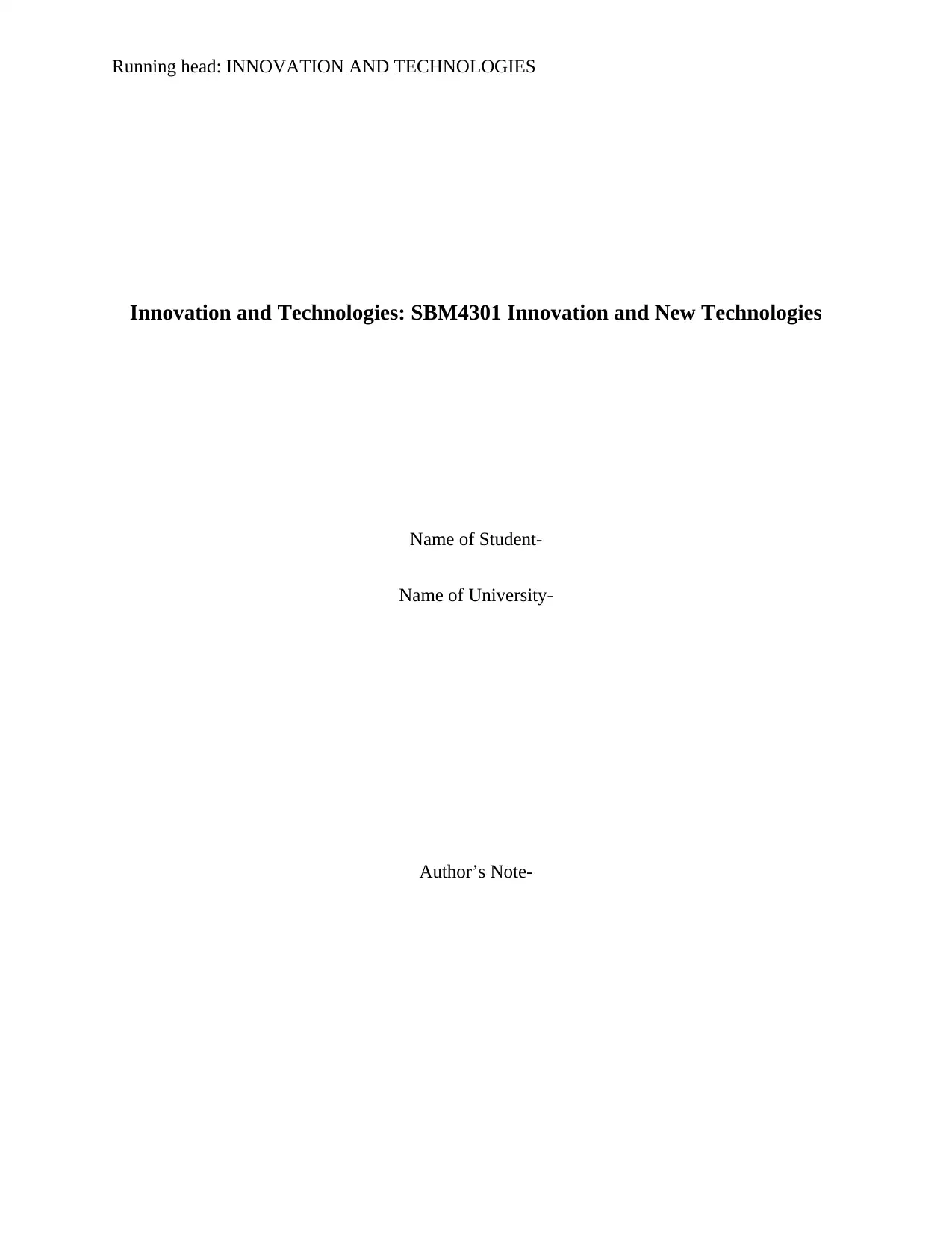
Running head: INNOVATION AND TECHNOLOGIES
Innovation and Technologies: SBM4301 Innovation and New Technologies
Name of Student-
Name of University-
Author’s Note-
Innovation and Technologies: SBM4301 Innovation and New Technologies
Name of Student-
Name of University-
Author’s Note-
Paraphrase This Document
Need a fresh take? Get an instant paraphrase of this document with our AI Paraphraser
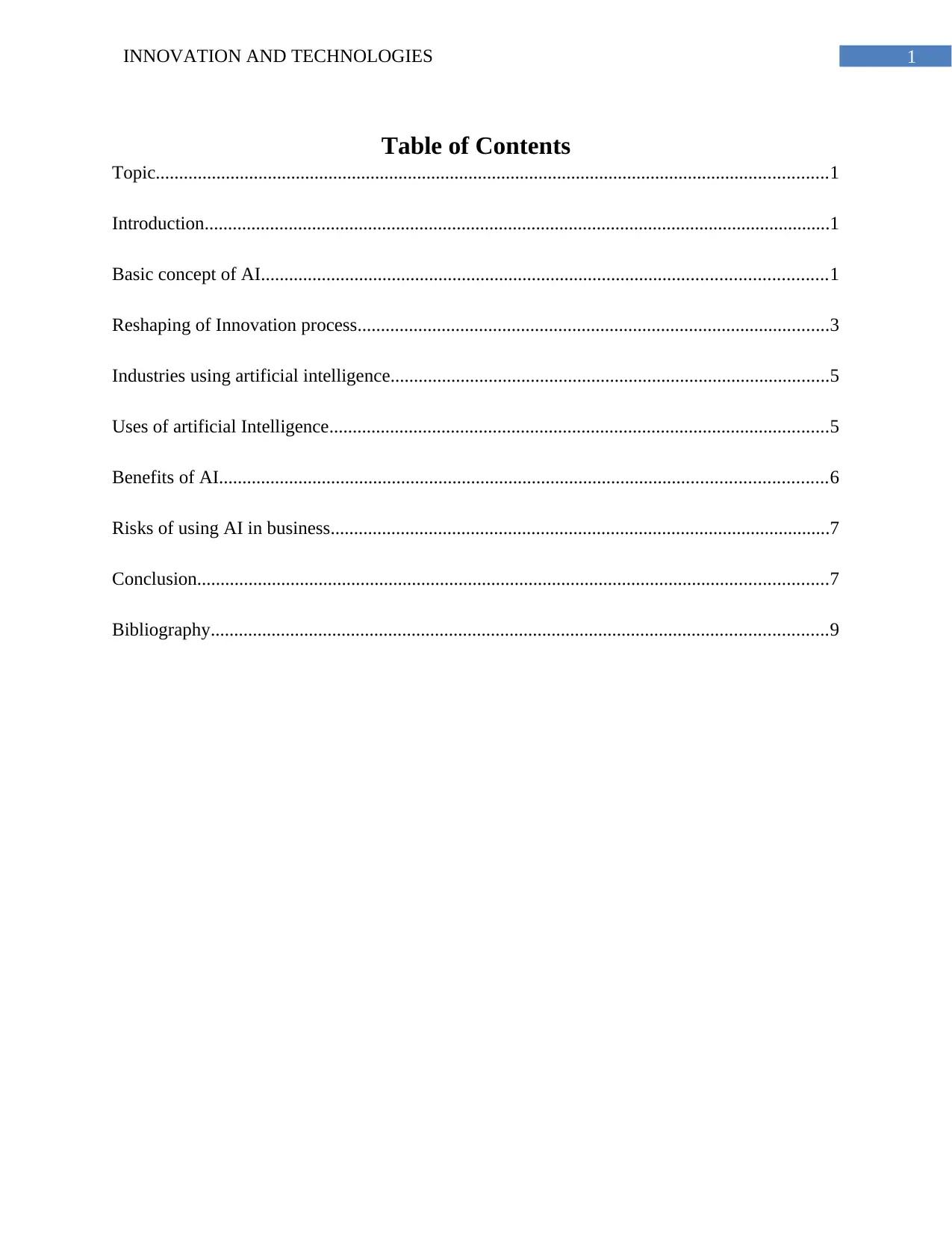
1INNOVATION AND TECHNOLOGIES
Table of Contents
Topic................................................................................................................................................1
Introduction......................................................................................................................................1
Basic concept of AI.........................................................................................................................1
Reshaping of Innovation process.....................................................................................................3
Industries using artificial intelligence..............................................................................................5
Uses of artificial Intelligence...........................................................................................................5
Benefits of AI..................................................................................................................................6
Risks of using AI in business...........................................................................................................7
Conclusion.......................................................................................................................................7
Bibliography....................................................................................................................................9
Table of Contents
Topic................................................................................................................................................1
Introduction......................................................................................................................................1
Basic concept of AI.........................................................................................................................1
Reshaping of Innovation process.....................................................................................................3
Industries using artificial intelligence..............................................................................................5
Uses of artificial Intelligence...........................................................................................................5
Benefits of AI..................................................................................................................................6
Risks of using AI in business...........................................................................................................7
Conclusion.......................................................................................................................................7
Bibliography....................................................................................................................................9
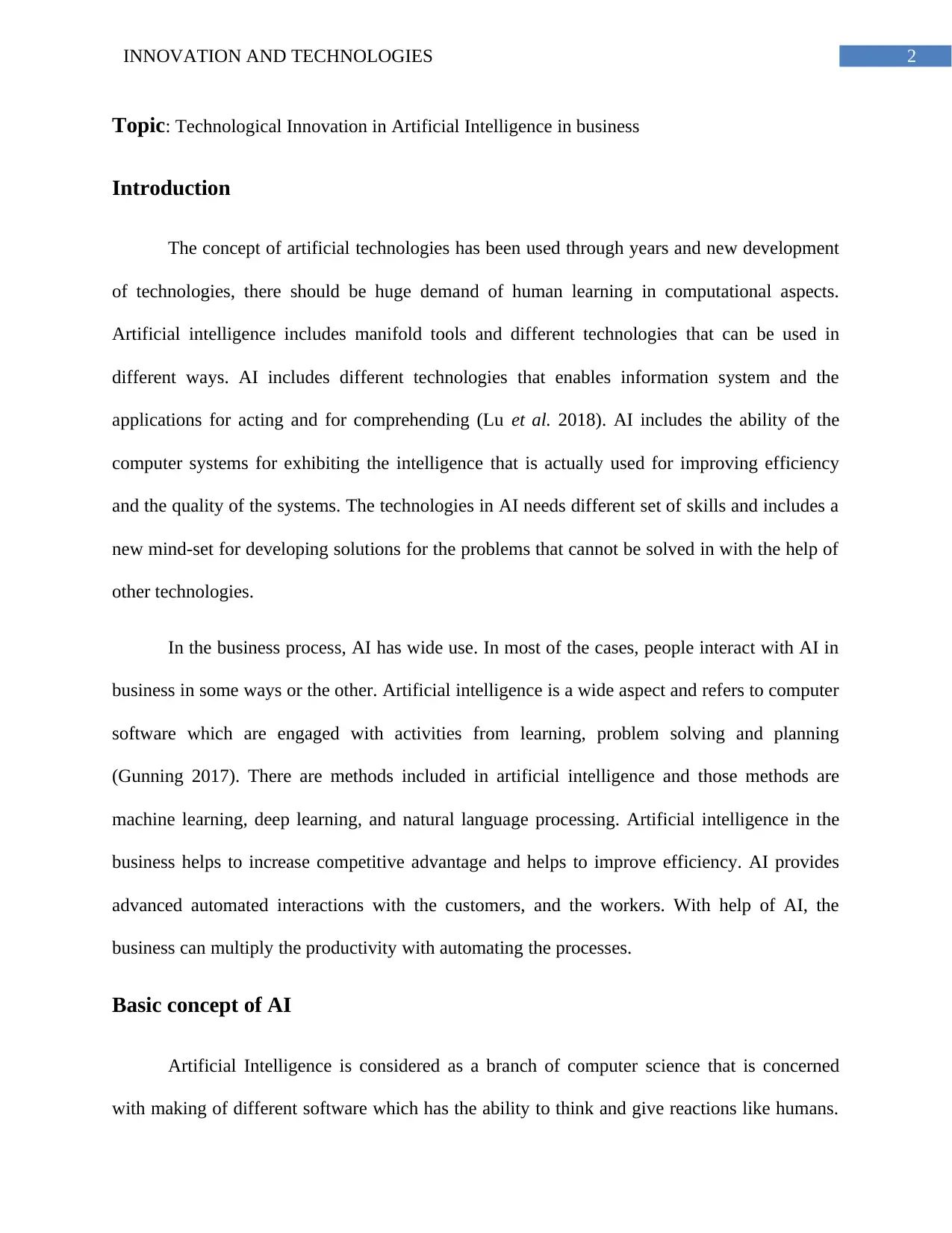
2INNOVATION AND TECHNOLOGIES
Topic: Technological Innovation in Artificial Intelligence in business
Introduction
The concept of artificial technologies has been used through years and new development
of technologies, there should be huge demand of human learning in computational aspects.
Artificial intelligence includes manifold tools and different technologies that can be used in
different ways. AI includes different technologies that enables information system and the
applications for acting and for comprehending (Lu et al. 2018). AI includes the ability of the
computer systems for exhibiting the intelligence that is actually used for improving efficiency
and the quality of the systems. The technologies in AI needs different set of skills and includes a
new mind-set for developing solutions for the problems that cannot be solved in with the help of
other technologies.
In the business process, AI has wide use. In most of the cases, people interact with AI in
business in some ways or the other. Artificial intelligence is a wide aspect and refers to computer
software which are engaged with activities from learning, problem solving and planning
(Gunning 2017). There are methods included in artificial intelligence and those methods are
machine learning, deep learning, and natural language processing. Artificial intelligence in the
business helps to increase competitive advantage and helps to improve efficiency. AI provides
advanced automated interactions with the customers, and the workers. With help of AI, the
business can multiply the productivity with automating the processes.
Basic concept of AI
Artificial Intelligence is considered as a branch of computer science that is concerned
with making of different software which has the ability to think and give reactions like humans.
Topic: Technological Innovation in Artificial Intelligence in business
Introduction
The concept of artificial technologies has been used through years and new development
of technologies, there should be huge demand of human learning in computational aspects.
Artificial intelligence includes manifold tools and different technologies that can be used in
different ways. AI includes different technologies that enables information system and the
applications for acting and for comprehending (Lu et al. 2018). AI includes the ability of the
computer systems for exhibiting the intelligence that is actually used for improving efficiency
and the quality of the systems. The technologies in AI needs different set of skills and includes a
new mind-set for developing solutions for the problems that cannot be solved in with the help of
other technologies.
In the business process, AI has wide use. In most of the cases, people interact with AI in
business in some ways or the other. Artificial intelligence is a wide aspect and refers to computer
software which are engaged with activities from learning, problem solving and planning
(Gunning 2017). There are methods included in artificial intelligence and those methods are
machine learning, deep learning, and natural language processing. Artificial intelligence in the
business helps to increase competitive advantage and helps to improve efficiency. AI provides
advanced automated interactions with the customers, and the workers. With help of AI, the
business can multiply the productivity with automating the processes.
Basic concept of AI
Artificial Intelligence is considered as a branch of computer science that is concerned
with making of different software which has the ability to think and give reactions like humans.
⊘ This is a preview!⊘
Do you want full access?
Subscribe today to unlock all pages.

Trusted by 1+ million students worldwide
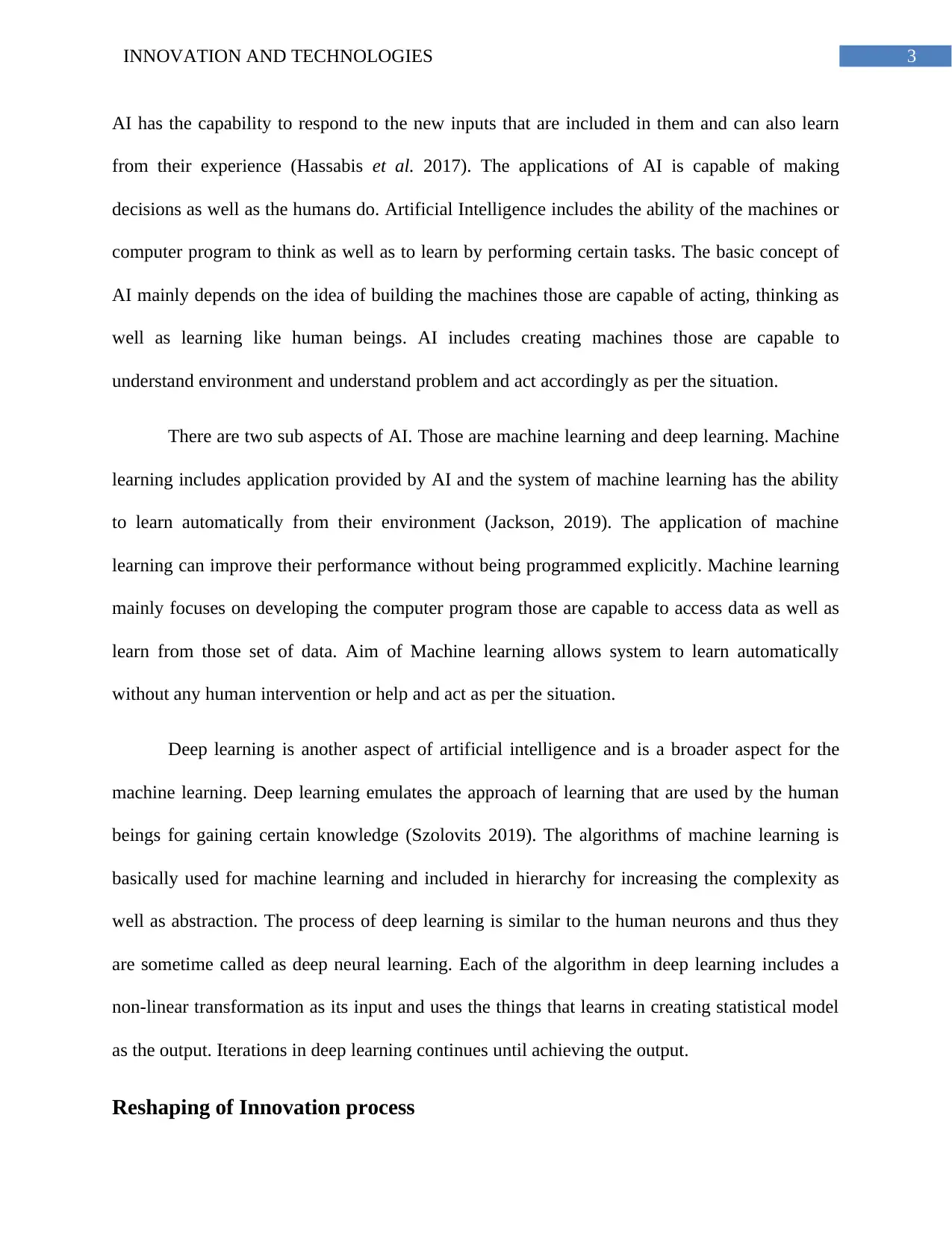
3INNOVATION AND TECHNOLOGIES
AI has the capability to respond to the new inputs that are included in them and can also learn
from their experience (Hassabis et al. 2017). The applications of AI is capable of making
decisions as well as the humans do. Artificial Intelligence includes the ability of the machines or
computer program to think as well as to learn by performing certain tasks. The basic concept of
AI mainly depends on the idea of building the machines those are capable of acting, thinking as
well as learning like human beings. AI includes creating machines those are capable to
understand environment and understand problem and act accordingly as per the situation.
There are two sub aspects of AI. Those are machine learning and deep learning. Machine
learning includes application provided by AI and the system of machine learning has the ability
to learn automatically from their environment (Jackson, 2019). The application of machine
learning can improve their performance without being programmed explicitly. Machine learning
mainly focuses on developing the computer program those are capable to access data as well as
learn from those set of data. Aim of Machine learning allows system to learn automatically
without any human intervention or help and act as per the situation.
Deep learning is another aspect of artificial intelligence and is a broader aspect for the
machine learning. Deep learning emulates the approach of learning that are used by the human
beings for gaining certain knowledge (Szolovits 2019). The algorithms of machine learning is
basically used for machine learning and included in hierarchy for increasing the complexity as
well as abstraction. The process of deep learning is similar to the human neurons and thus they
are sometime called as deep neural learning. Each of the algorithm in deep learning includes a
non-linear transformation as its input and uses the things that learns in creating statistical model
as the output. Iterations in deep learning continues until achieving the output.
Reshaping of Innovation process
AI has the capability to respond to the new inputs that are included in them and can also learn
from their experience (Hassabis et al. 2017). The applications of AI is capable of making
decisions as well as the humans do. Artificial Intelligence includes the ability of the machines or
computer program to think as well as to learn by performing certain tasks. The basic concept of
AI mainly depends on the idea of building the machines those are capable of acting, thinking as
well as learning like human beings. AI includes creating machines those are capable to
understand environment and understand problem and act accordingly as per the situation.
There are two sub aspects of AI. Those are machine learning and deep learning. Machine
learning includes application provided by AI and the system of machine learning has the ability
to learn automatically from their environment (Jackson, 2019). The application of machine
learning can improve their performance without being programmed explicitly. Machine learning
mainly focuses on developing the computer program those are capable to access data as well as
learn from those set of data. Aim of Machine learning allows system to learn automatically
without any human intervention or help and act as per the situation.
Deep learning is another aspect of artificial intelligence and is a broader aspect for the
machine learning. Deep learning emulates the approach of learning that are used by the human
beings for gaining certain knowledge (Szolovits 2019). The algorithms of machine learning is
basically used for machine learning and included in hierarchy for increasing the complexity as
well as abstraction. The process of deep learning is similar to the human neurons and thus they
are sometime called as deep neural learning. Each of the algorithm in deep learning includes a
non-linear transformation as its input and uses the things that learns in creating statistical model
as the output. Iterations in deep learning continues until achieving the output.
Reshaping of Innovation process
Paraphrase This Document
Need a fresh take? Get an instant paraphrase of this document with our AI Paraphraser
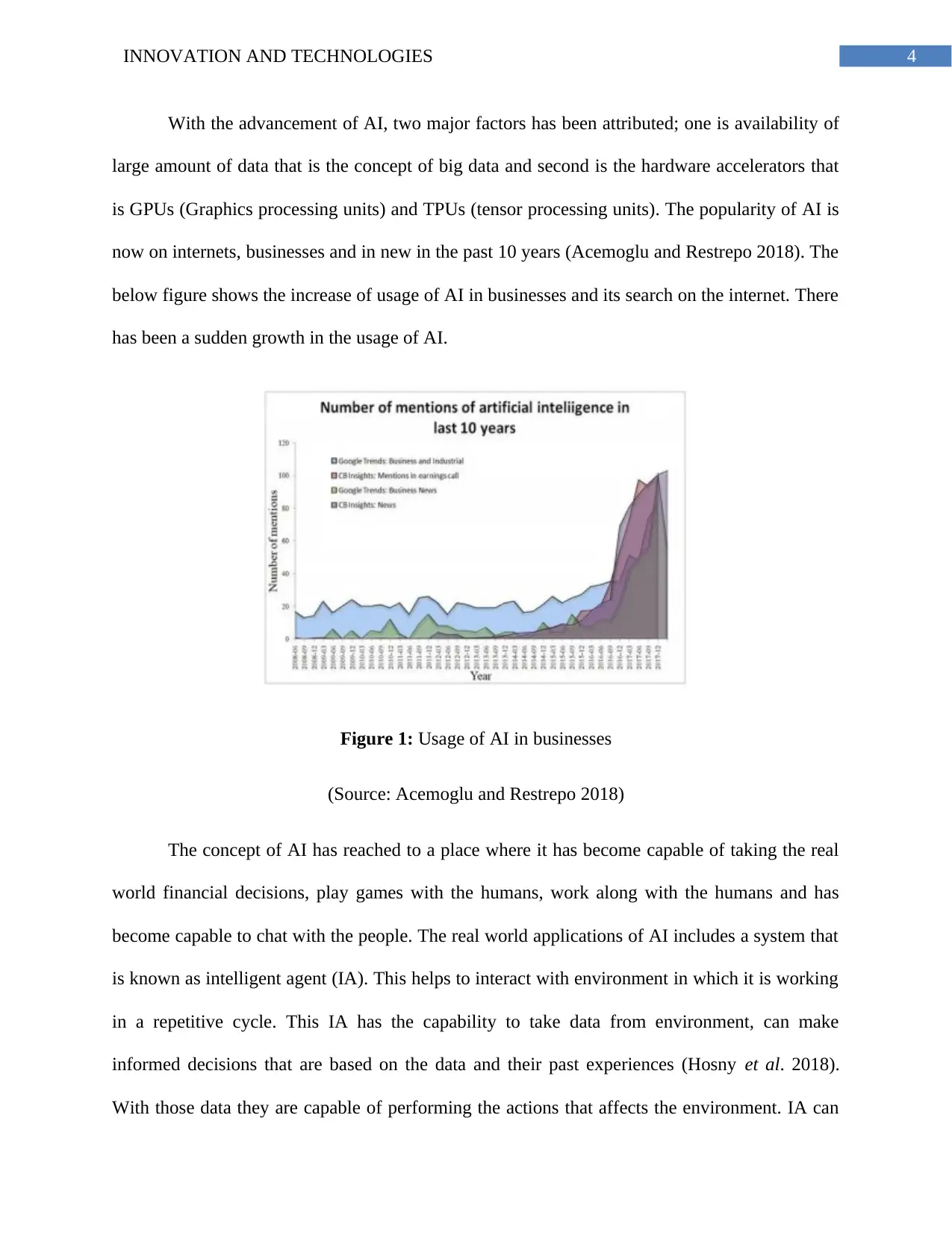
4INNOVATION AND TECHNOLOGIES
With the advancement of AI, two major factors has been attributed; one is availability of
large amount of data that is the concept of big data and second is the hardware accelerators that
is GPUs (Graphics processing units) and TPUs (tensor processing units). The popularity of AI is
now on internets, businesses and in new in the past 10 years (Acemoglu and Restrepo 2018). The
below figure shows the increase of usage of AI in businesses and its search on the internet. There
has been a sudden growth in the usage of AI.
Figure 1: Usage of AI in businesses
(Source: Acemoglu and Restrepo 2018)
The concept of AI has reached to a place where it has become capable of taking the real
world financial decisions, play games with the humans, work along with the humans and has
become capable to chat with the people. The real world applications of AI includes a system that
is known as intelligent agent (IA). This helps to interact with environment in which it is working
in a repetitive cycle. This IA has the capability to take data from environment, can make
informed decisions that are based on the data and their past experiences (Hosny et al. 2018).
With those data they are capable of performing the actions that affects the environment. IA can
With the advancement of AI, two major factors has been attributed; one is availability of
large amount of data that is the concept of big data and second is the hardware accelerators that
is GPUs (Graphics processing units) and TPUs (tensor processing units). The popularity of AI is
now on internets, businesses and in new in the past 10 years (Acemoglu and Restrepo 2018). The
below figure shows the increase of usage of AI in businesses and its search on the internet. There
has been a sudden growth in the usage of AI.
Figure 1: Usage of AI in businesses
(Source: Acemoglu and Restrepo 2018)
The concept of AI has reached to a place where it has become capable of taking the real
world financial decisions, play games with the humans, work along with the humans and has
become capable to chat with the people. The real world applications of AI includes a system that
is known as intelligent agent (IA). This helps to interact with environment in which it is working
in a repetitive cycle. This IA has the capability to take data from environment, can make
informed decisions that are based on the data and their past experiences (Hosny et al. 2018).
With those data they are capable of performing the actions that affects the environment. IA can
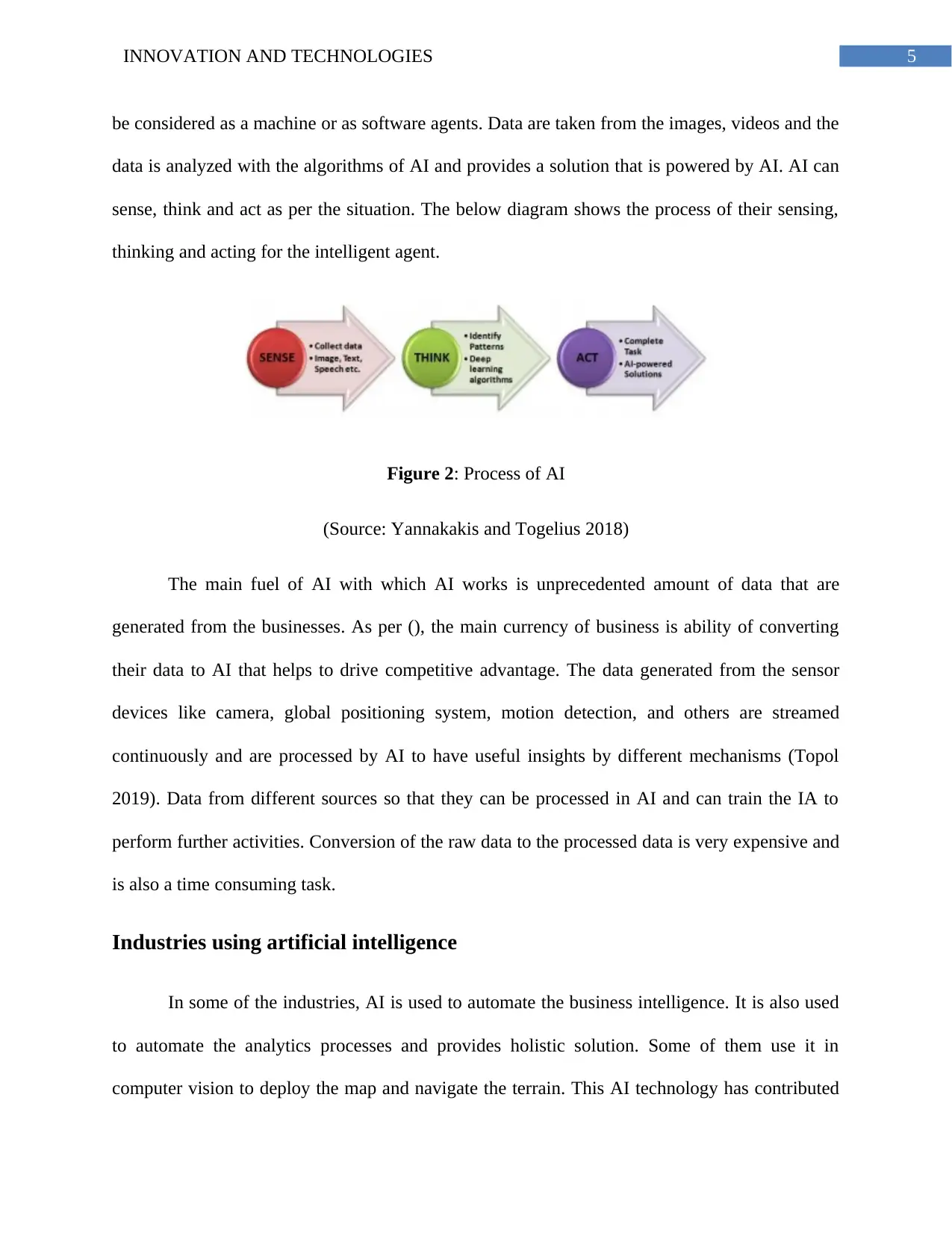
5INNOVATION AND TECHNOLOGIES
be considered as a machine or as software agents. Data are taken from the images, videos and the
data is analyzed with the algorithms of AI and provides a solution that is powered by AI. AI can
sense, think and act as per the situation. The below diagram shows the process of their sensing,
thinking and acting for the intelligent agent.
Figure 2: Process of AI
(Source: Yannakakis and Togelius 2018)
The main fuel of AI with which AI works is unprecedented amount of data that are
generated from the businesses. As per (), the main currency of business is ability of converting
their data to AI that helps to drive competitive advantage. The data generated from the sensor
devices like camera, global positioning system, motion detection, and others are streamed
continuously and are processed by AI to have useful insights by different mechanisms (Topol
2019). Data from different sources so that they can be processed in AI and can train the IA to
perform further activities. Conversion of the raw data to the processed data is very expensive and
is also a time consuming task.
Industries using artificial intelligence
In some of the industries, AI is used to automate the business intelligence. It is also used
to automate the analytics processes and provides holistic solution. Some of them use it in
computer vision to deploy the map and navigate the terrain. This AI technology has contributed
be considered as a machine or as software agents. Data are taken from the images, videos and the
data is analyzed with the algorithms of AI and provides a solution that is powered by AI. AI can
sense, think and act as per the situation. The below diagram shows the process of their sensing,
thinking and acting for the intelligent agent.
Figure 2: Process of AI
(Source: Yannakakis and Togelius 2018)
The main fuel of AI with which AI works is unprecedented amount of data that are
generated from the businesses. As per (), the main currency of business is ability of converting
their data to AI that helps to drive competitive advantage. The data generated from the sensor
devices like camera, global positioning system, motion detection, and others are streamed
continuously and are processed by AI to have useful insights by different mechanisms (Topol
2019). Data from different sources so that they can be processed in AI and can train the IA to
perform further activities. Conversion of the raw data to the processed data is very expensive and
is also a time consuming task.
Industries using artificial intelligence
In some of the industries, AI is used to automate the business intelligence. It is also used
to automate the analytics processes and provides holistic solution. Some of them use it in
computer vision to deploy the map and navigate the terrain. This AI technology has contributed
⊘ This is a preview!⊘
Do you want full access?
Subscribe today to unlock all pages.

Trusted by 1+ million students worldwide
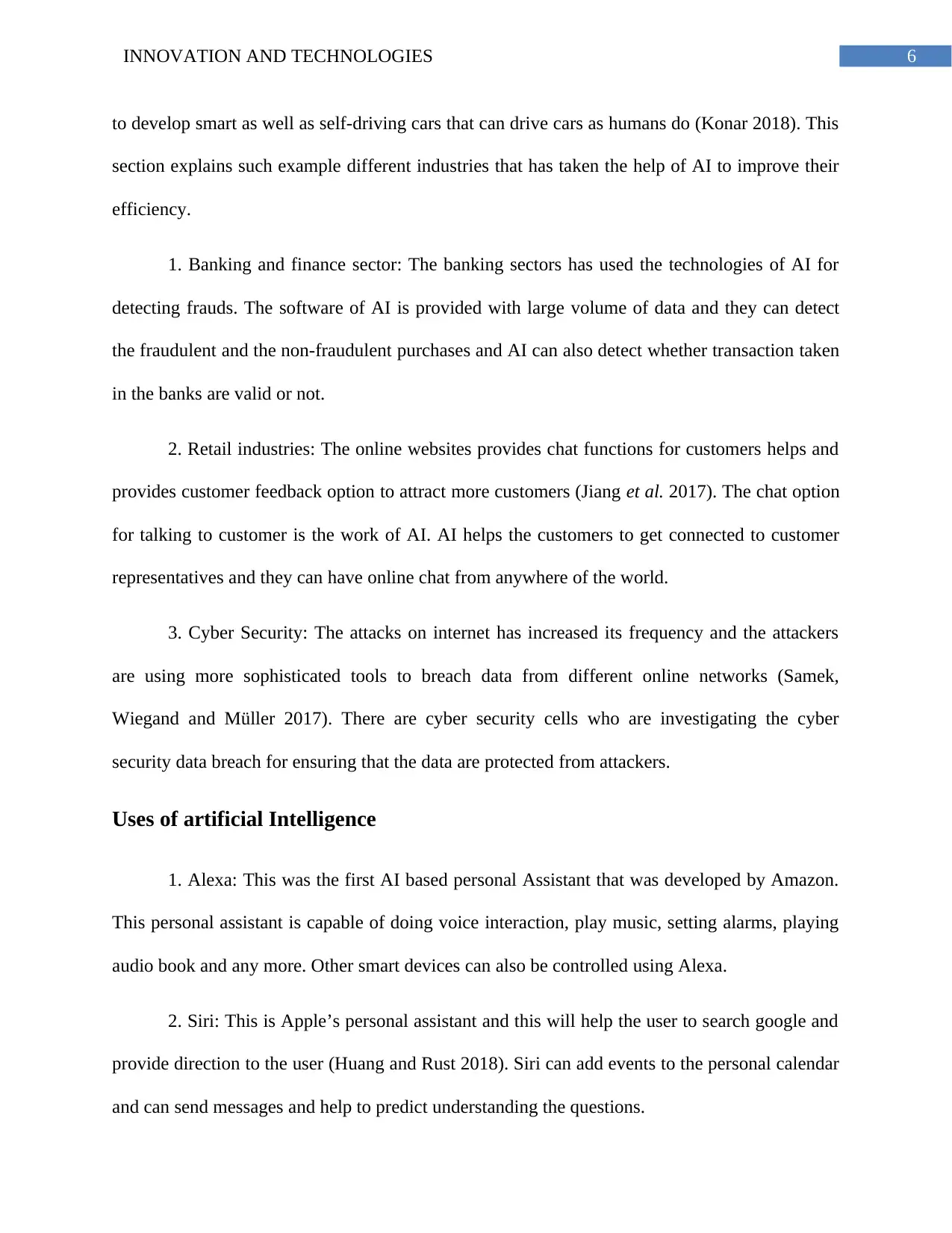
6INNOVATION AND TECHNOLOGIES
to develop smart as well as self-driving cars that can drive cars as humans do (Konar 2018). This
section explains such example different industries that has taken the help of AI to improve their
efficiency.
1. Banking and finance sector: The banking sectors has used the technologies of AI for
detecting frauds. The software of AI is provided with large volume of data and they can detect
the fraudulent and the non-fraudulent purchases and AI can also detect whether transaction taken
in the banks are valid or not.
2. Retail industries: The online websites provides chat functions for customers helps and
provides customer feedback option to attract more customers (Jiang et al. 2017). The chat option
for talking to customer is the work of AI. AI helps the customers to get connected to customer
representatives and they can have online chat from anywhere of the world.
3. Cyber Security: The attacks on internet has increased its frequency and the attackers
are using more sophisticated tools to breach data from different online networks (Samek,
Wiegand and Müller 2017). There are cyber security cells who are investigating the cyber
security data breach for ensuring that the data are protected from attackers.
Uses of artificial Intelligence
1. Alexa: This was the first AI based personal Assistant that was developed by Amazon.
This personal assistant is capable of doing voice interaction, play music, setting alarms, playing
audio book and any more. Other smart devices can also be controlled using Alexa.
2. Siri: This is Apple’s personal assistant and this will help the user to search google and
provide direction to the user (Huang and Rust 2018). Siri can add events to the personal calendar
and can send messages and help to predict understanding the questions.
to develop smart as well as self-driving cars that can drive cars as humans do (Konar 2018). This
section explains such example different industries that has taken the help of AI to improve their
efficiency.
1. Banking and finance sector: The banking sectors has used the technologies of AI for
detecting frauds. The software of AI is provided with large volume of data and they can detect
the fraudulent and the non-fraudulent purchases and AI can also detect whether transaction taken
in the banks are valid or not.
2. Retail industries: The online websites provides chat functions for customers helps and
provides customer feedback option to attract more customers (Jiang et al. 2017). The chat option
for talking to customer is the work of AI. AI helps the customers to get connected to customer
representatives and they can have online chat from anywhere of the world.
3. Cyber Security: The attacks on internet has increased its frequency and the attackers
are using more sophisticated tools to breach data from different online networks (Samek,
Wiegand and Müller 2017). There are cyber security cells who are investigating the cyber
security data breach for ensuring that the data are protected from attackers.
Uses of artificial Intelligence
1. Alexa: This was the first AI based personal Assistant that was developed by Amazon.
This personal assistant is capable of doing voice interaction, play music, setting alarms, playing
audio book and any more. Other smart devices can also be controlled using Alexa.
2. Siri: This is Apple’s personal assistant and this will help the user to search google and
provide direction to the user (Huang and Rust 2018). Siri can add events to the personal calendar
and can send messages and help to predict understanding the questions.
Paraphrase This Document
Need a fresh take? Get an instant paraphrase of this document with our AI Paraphraser
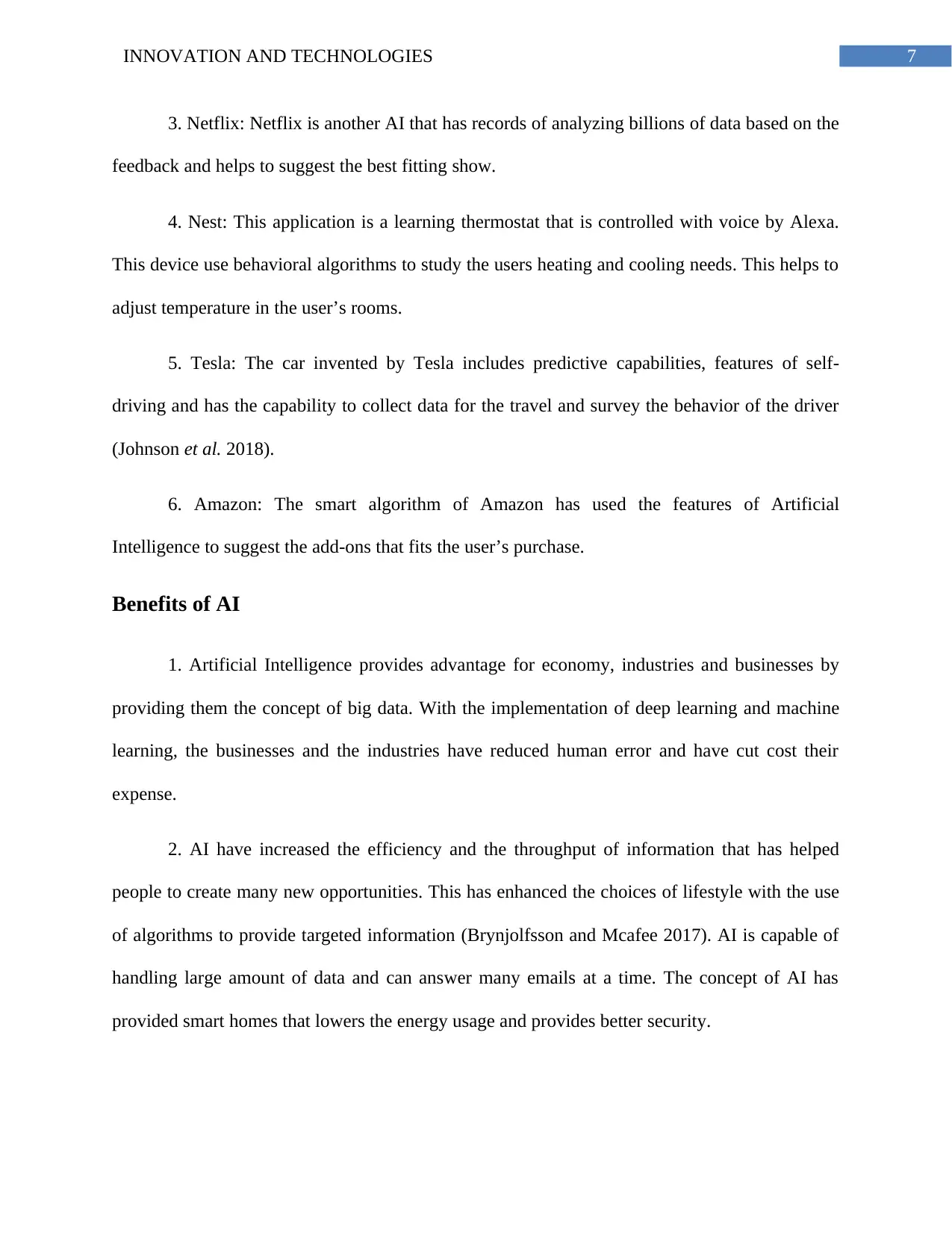
7INNOVATION AND TECHNOLOGIES
3. Netflix: Netflix is another AI that has records of analyzing billions of data based on the
feedback and helps to suggest the best fitting show.
4. Nest: This application is a learning thermostat that is controlled with voice by Alexa.
This device use behavioral algorithms to study the users heating and cooling needs. This helps to
adjust temperature in the user’s rooms.
5. Tesla: The car invented by Tesla includes predictive capabilities, features of self-
driving and has the capability to collect data for the travel and survey the behavior of the driver
(Johnson et al. 2018).
6. Amazon: The smart algorithm of Amazon has used the features of Artificial
Intelligence to suggest the add-ons that fits the user’s purchase.
Benefits of AI
1. Artificial Intelligence provides advantage for economy, industries and businesses by
providing them the concept of big data. With the implementation of deep learning and machine
learning, the businesses and the industries have reduced human error and have cut cost their
expense.
2. AI have increased the efficiency and the throughput of information that has helped
people to create many new opportunities. This has enhanced the choices of lifestyle with the use
of algorithms to provide targeted information (Brynjolfsson and Mcafee 2017). AI is capable of
handling large amount of data and can answer many emails at a time. The concept of AI has
provided smart homes that lowers the energy usage and provides better security.
3. Netflix: Netflix is another AI that has records of analyzing billions of data based on the
feedback and helps to suggest the best fitting show.
4. Nest: This application is a learning thermostat that is controlled with voice by Alexa.
This device use behavioral algorithms to study the users heating and cooling needs. This helps to
adjust temperature in the user’s rooms.
5. Tesla: The car invented by Tesla includes predictive capabilities, features of self-
driving and has the capability to collect data for the travel and survey the behavior of the driver
(Johnson et al. 2018).
6. Amazon: The smart algorithm of Amazon has used the features of Artificial
Intelligence to suggest the add-ons that fits the user’s purchase.
Benefits of AI
1. Artificial Intelligence provides advantage for economy, industries and businesses by
providing them the concept of big data. With the implementation of deep learning and machine
learning, the businesses and the industries have reduced human error and have cut cost their
expense.
2. AI have increased the efficiency and the throughput of information that has helped
people to create many new opportunities. This has enhanced the choices of lifestyle with the use
of algorithms to provide targeted information (Brynjolfsson and Mcafee 2017). AI is capable of
handling large amount of data and can answer many emails at a time. The concept of AI has
provided smart homes that lowers the energy usage and provides better security.
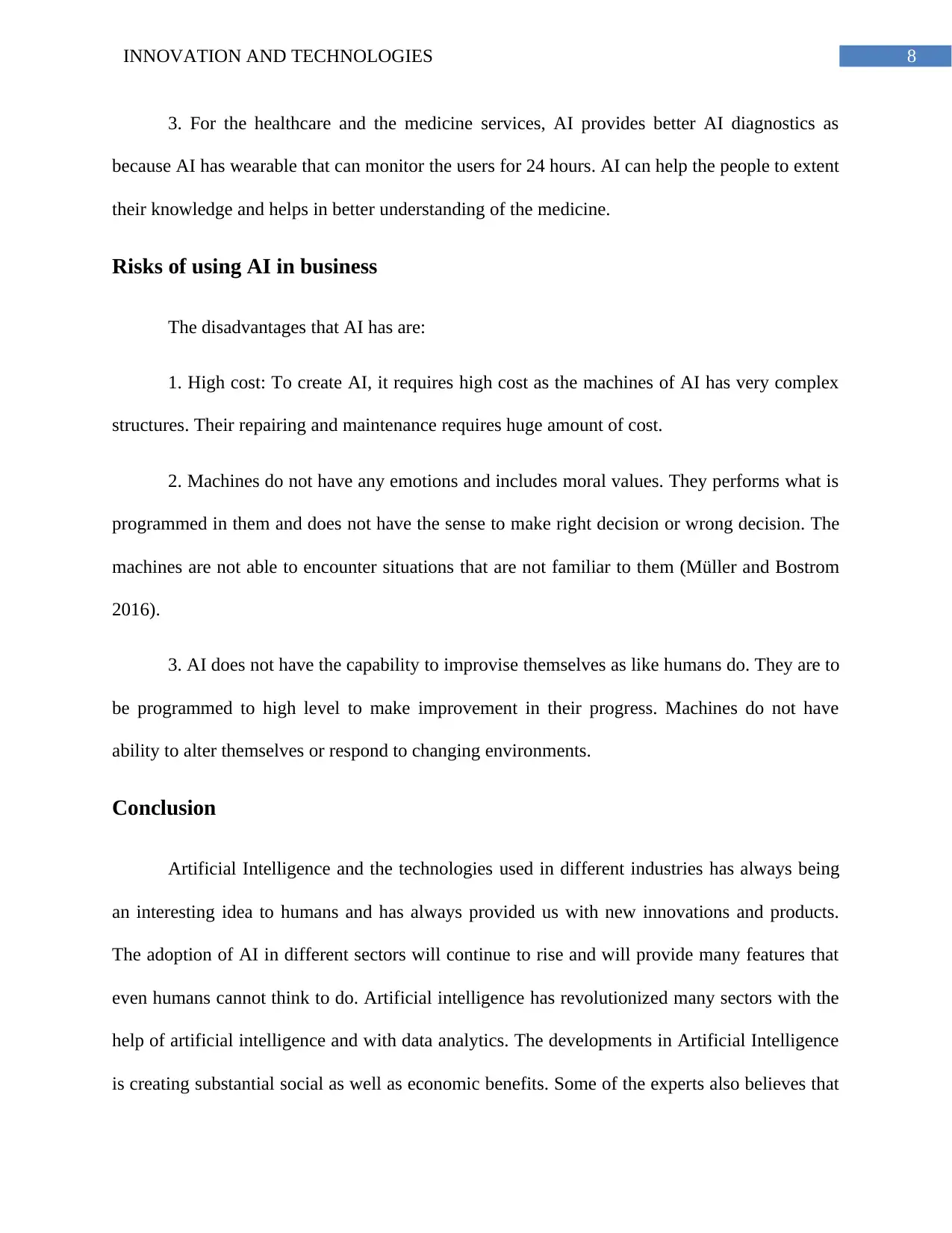
8INNOVATION AND TECHNOLOGIES
3. For the healthcare and the medicine services, AI provides better AI diagnostics as
because AI has wearable that can monitor the users for 24 hours. AI can help the people to extent
their knowledge and helps in better understanding of the medicine.
Risks of using AI in business
The disadvantages that AI has are:
1. High cost: To create AI, it requires high cost as the machines of AI has very complex
structures. Their repairing and maintenance requires huge amount of cost.
2. Machines do not have any emotions and includes moral values. They performs what is
programmed in them and does not have the sense to make right decision or wrong decision. The
machines are not able to encounter situations that are not familiar to them (Müller and Bostrom
2016).
3. AI does not have the capability to improvise themselves as like humans do. They are to
be programmed to high level to make improvement in their progress. Machines do not have
ability to alter themselves or respond to changing environments.
Conclusion
Artificial Intelligence and the technologies used in different industries has always being
an interesting idea to humans and has always provided us with new innovations and products.
The adoption of AI in different sectors will continue to rise and will provide many features that
even humans cannot think to do. Artificial intelligence has revolutionized many sectors with the
help of artificial intelligence and with data analytics. The developments in Artificial Intelligence
is creating substantial social as well as economic benefits. Some of the experts also believes that
3. For the healthcare and the medicine services, AI provides better AI diagnostics as
because AI has wearable that can monitor the users for 24 hours. AI can help the people to extent
their knowledge and helps in better understanding of the medicine.
Risks of using AI in business
The disadvantages that AI has are:
1. High cost: To create AI, it requires high cost as the machines of AI has very complex
structures. Their repairing and maintenance requires huge amount of cost.
2. Machines do not have any emotions and includes moral values. They performs what is
programmed in them and does not have the sense to make right decision or wrong decision. The
machines are not able to encounter situations that are not familiar to them (Müller and Bostrom
2016).
3. AI does not have the capability to improvise themselves as like humans do. They are to
be programmed to high level to make improvement in their progress. Machines do not have
ability to alter themselves or respond to changing environments.
Conclusion
Artificial Intelligence and the technologies used in different industries has always being
an interesting idea to humans and has always provided us with new innovations and products.
The adoption of AI in different sectors will continue to rise and will provide many features that
even humans cannot think to do. Artificial intelligence has revolutionized many sectors with the
help of artificial intelligence and with data analytics. The developments in Artificial Intelligence
is creating substantial social as well as economic benefits. Some of the experts also believes that
⊘ This is a preview!⊘
Do you want full access?
Subscribe today to unlock all pages.

Trusted by 1+ million students worldwide
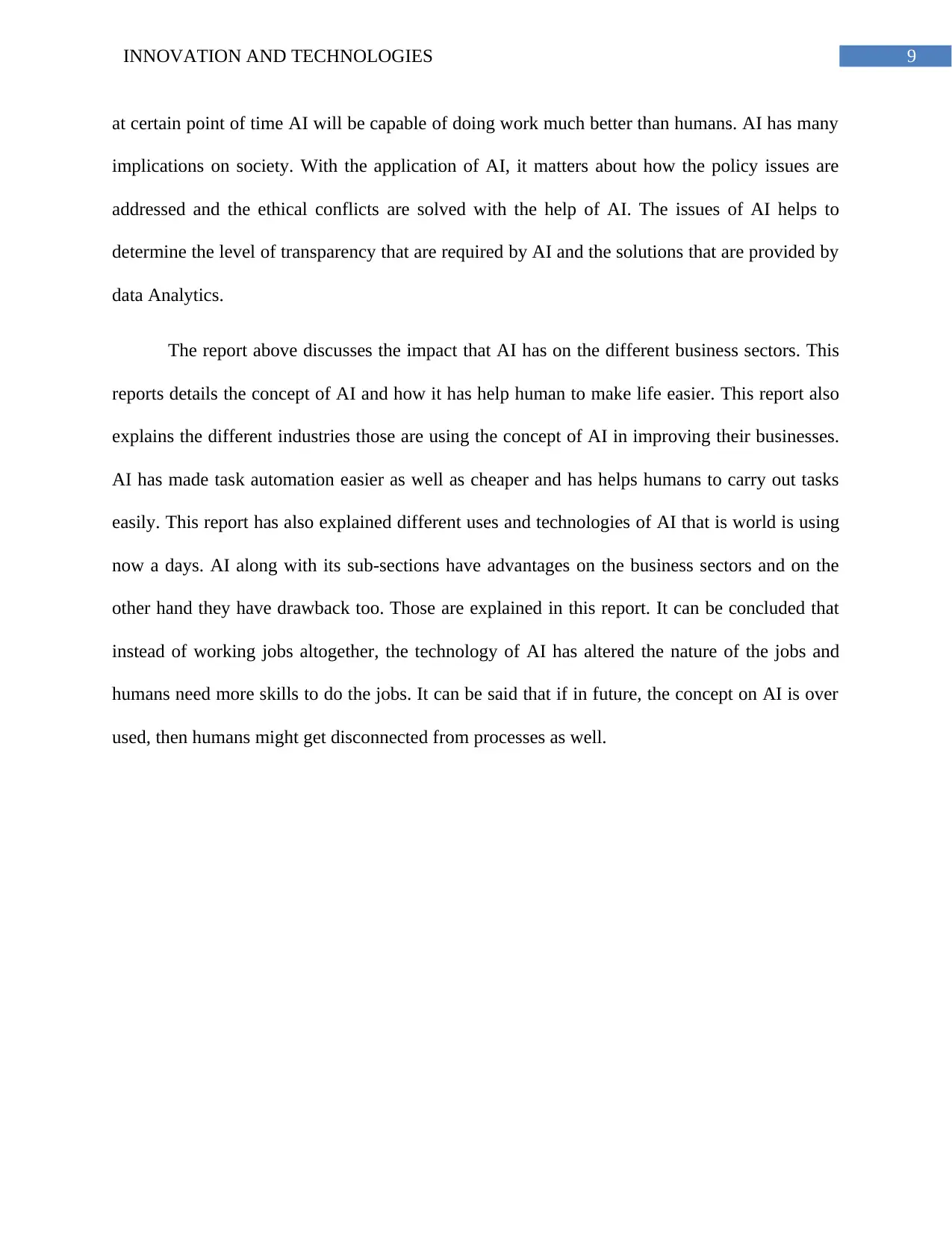
9INNOVATION AND TECHNOLOGIES
at certain point of time AI will be capable of doing work much better than humans. AI has many
implications on society. With the application of AI, it matters about how the policy issues are
addressed and the ethical conflicts are solved with the help of AI. The issues of AI helps to
determine the level of transparency that are required by AI and the solutions that are provided by
data Analytics.
The report above discusses the impact that AI has on the different business sectors. This
reports details the concept of AI and how it has help human to make life easier. This report also
explains the different industries those are using the concept of AI in improving their businesses.
AI has made task automation easier as well as cheaper and has helps humans to carry out tasks
easily. This report has also explained different uses and technologies of AI that is world is using
now a days. AI along with its sub-sections have advantages on the business sectors and on the
other hand they have drawback too. Those are explained in this report. It can be concluded that
instead of working jobs altogether, the technology of AI has altered the nature of the jobs and
humans need more skills to do the jobs. It can be said that if in future, the concept on AI is over
used, then humans might get disconnected from processes as well.
at certain point of time AI will be capable of doing work much better than humans. AI has many
implications on society. With the application of AI, it matters about how the policy issues are
addressed and the ethical conflicts are solved with the help of AI. The issues of AI helps to
determine the level of transparency that are required by AI and the solutions that are provided by
data Analytics.
The report above discusses the impact that AI has on the different business sectors. This
reports details the concept of AI and how it has help human to make life easier. This report also
explains the different industries those are using the concept of AI in improving their businesses.
AI has made task automation easier as well as cheaper and has helps humans to carry out tasks
easily. This report has also explained different uses and technologies of AI that is world is using
now a days. AI along with its sub-sections have advantages on the business sectors and on the
other hand they have drawback too. Those are explained in this report. It can be concluded that
instead of working jobs altogether, the technology of AI has altered the nature of the jobs and
humans need more skills to do the jobs. It can be said that if in future, the concept on AI is over
used, then humans might get disconnected from processes as well.
Paraphrase This Document
Need a fresh take? Get an instant paraphrase of this document with our AI Paraphraser
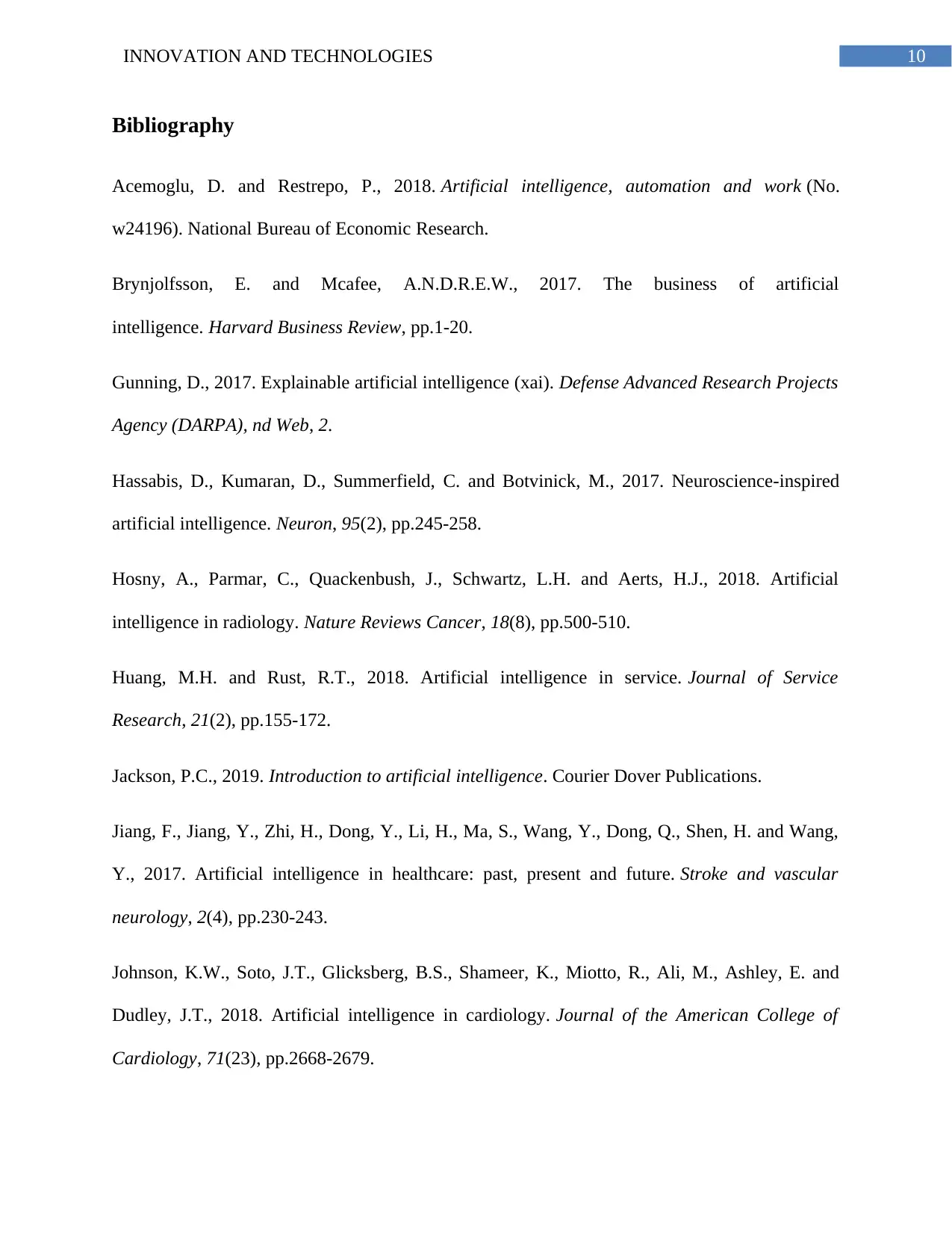
10INNOVATION AND TECHNOLOGIES
Bibliography
Acemoglu, D. and Restrepo, P., 2018. Artificial intelligence, automation and work (No.
w24196). National Bureau of Economic Research.
Brynjolfsson, E. and Mcafee, A.N.D.R.E.W., 2017. The business of artificial
intelligence. Harvard Business Review, pp.1-20.
Gunning, D., 2017. Explainable artificial intelligence (xai). Defense Advanced Research Projects
Agency (DARPA), nd Web, 2.
Hassabis, D., Kumaran, D., Summerfield, C. and Botvinick, M., 2017. Neuroscience-inspired
artificial intelligence. Neuron, 95(2), pp.245-258.
Hosny, A., Parmar, C., Quackenbush, J., Schwartz, L.H. and Aerts, H.J., 2018. Artificial
intelligence in radiology. Nature Reviews Cancer, 18(8), pp.500-510.
Huang, M.H. and Rust, R.T., 2018. Artificial intelligence in service. Journal of Service
Research, 21(2), pp.155-172.
Jackson, P.C., 2019. Introduction to artificial intelligence. Courier Dover Publications.
Jiang, F., Jiang, Y., Zhi, H., Dong, Y., Li, H., Ma, S., Wang, Y., Dong, Q., Shen, H. and Wang,
Y., 2017. Artificial intelligence in healthcare: past, present and future. Stroke and vascular
neurology, 2(4), pp.230-243.
Johnson, K.W., Soto, J.T., Glicksberg, B.S., Shameer, K., Miotto, R., Ali, M., Ashley, E. and
Dudley, J.T., 2018. Artificial intelligence in cardiology. Journal of the American College of
Cardiology, 71(23), pp.2668-2679.
Bibliography
Acemoglu, D. and Restrepo, P., 2018. Artificial intelligence, automation and work (No.
w24196). National Bureau of Economic Research.
Brynjolfsson, E. and Mcafee, A.N.D.R.E.W., 2017. The business of artificial
intelligence. Harvard Business Review, pp.1-20.
Gunning, D., 2017. Explainable artificial intelligence (xai). Defense Advanced Research Projects
Agency (DARPA), nd Web, 2.
Hassabis, D., Kumaran, D., Summerfield, C. and Botvinick, M., 2017. Neuroscience-inspired
artificial intelligence. Neuron, 95(2), pp.245-258.
Hosny, A., Parmar, C., Quackenbush, J., Schwartz, L.H. and Aerts, H.J., 2018. Artificial
intelligence in radiology. Nature Reviews Cancer, 18(8), pp.500-510.
Huang, M.H. and Rust, R.T., 2018. Artificial intelligence in service. Journal of Service
Research, 21(2), pp.155-172.
Jackson, P.C., 2019. Introduction to artificial intelligence. Courier Dover Publications.
Jiang, F., Jiang, Y., Zhi, H., Dong, Y., Li, H., Ma, S., Wang, Y., Dong, Q., Shen, H. and Wang,
Y., 2017. Artificial intelligence in healthcare: past, present and future. Stroke and vascular
neurology, 2(4), pp.230-243.
Johnson, K.W., Soto, J.T., Glicksberg, B.S., Shameer, K., Miotto, R., Ali, M., Ashley, E. and
Dudley, J.T., 2018. Artificial intelligence in cardiology. Journal of the American College of
Cardiology, 71(23), pp.2668-2679.
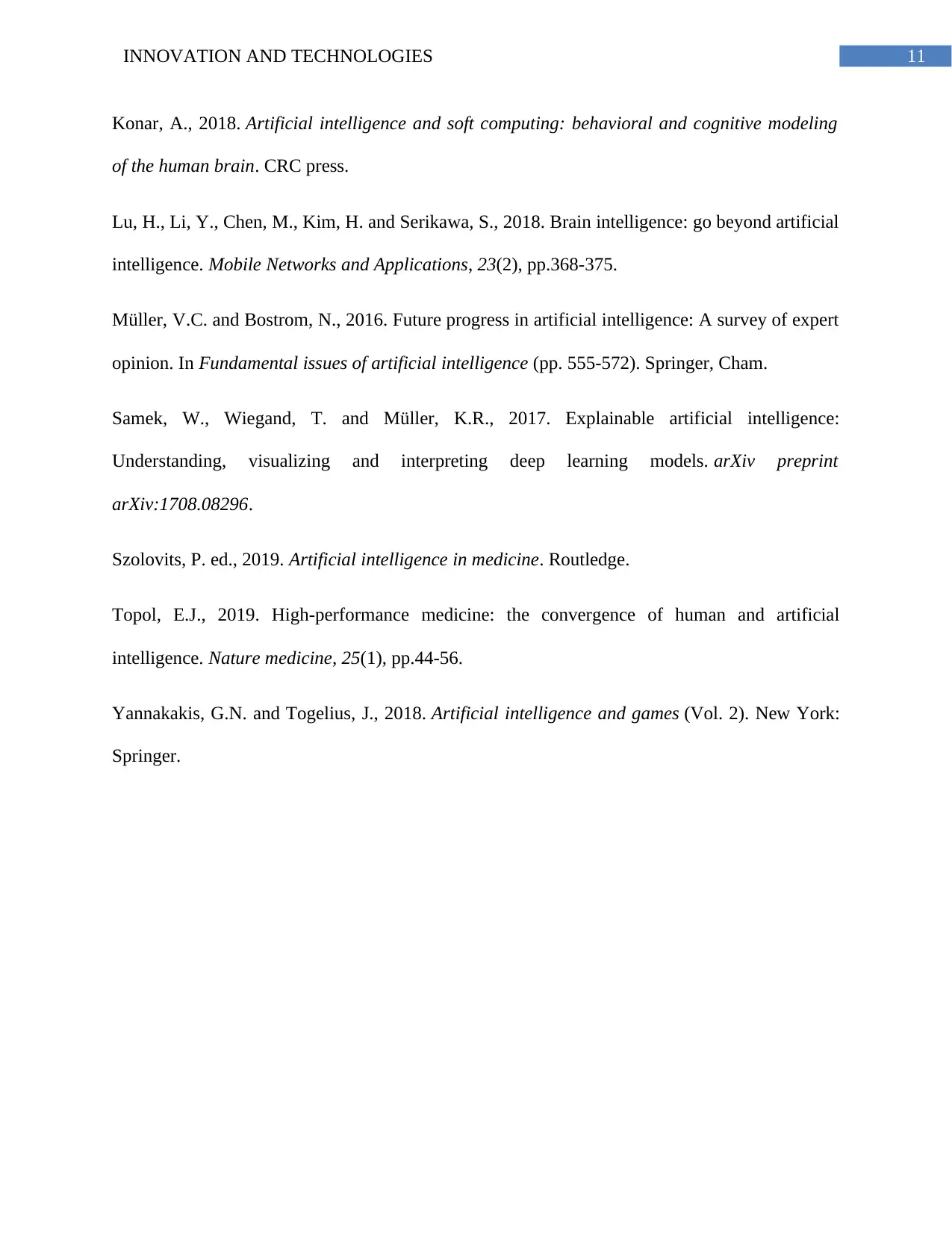
11INNOVATION AND TECHNOLOGIES
Konar, A., 2018. Artificial intelligence and soft computing: behavioral and cognitive modeling
of the human brain. CRC press.
Lu, H., Li, Y., Chen, M., Kim, H. and Serikawa, S., 2018. Brain intelligence: go beyond artificial
intelligence. Mobile Networks and Applications, 23(2), pp.368-375.
Müller, V.C. and Bostrom, N., 2016. Future progress in artificial intelligence: A survey of expert
opinion. In Fundamental issues of artificial intelligence (pp. 555-572). Springer, Cham.
Samek, W., Wiegand, T. and Müller, K.R., 2017. Explainable artificial intelligence:
Understanding, visualizing and interpreting deep learning models. arXiv preprint
arXiv:1708.08296.
Szolovits, P. ed., 2019. Artificial intelligence in medicine. Routledge.
Topol, E.J., 2019. High-performance medicine: the convergence of human and artificial
intelligence. Nature medicine, 25(1), pp.44-56.
Yannakakis, G.N. and Togelius, J., 2018. Artificial intelligence and games (Vol. 2). New York:
Springer.
Konar, A., 2018. Artificial intelligence and soft computing: behavioral and cognitive modeling
of the human brain. CRC press.
Lu, H., Li, Y., Chen, M., Kim, H. and Serikawa, S., 2018. Brain intelligence: go beyond artificial
intelligence. Mobile Networks and Applications, 23(2), pp.368-375.
Müller, V.C. and Bostrom, N., 2016. Future progress in artificial intelligence: A survey of expert
opinion. In Fundamental issues of artificial intelligence (pp. 555-572). Springer, Cham.
Samek, W., Wiegand, T. and Müller, K.R., 2017. Explainable artificial intelligence:
Understanding, visualizing and interpreting deep learning models. arXiv preprint
arXiv:1708.08296.
Szolovits, P. ed., 2019. Artificial intelligence in medicine. Routledge.
Topol, E.J., 2019. High-performance medicine: the convergence of human and artificial
intelligence. Nature medicine, 25(1), pp.44-56.
Yannakakis, G.N. and Togelius, J., 2018. Artificial intelligence and games (Vol. 2). New York:
Springer.
⊘ This is a preview!⊘
Do you want full access?
Subscribe today to unlock all pages.

Trusted by 1+ million students worldwide
1 out of 12
Related Documents
Your All-in-One AI-Powered Toolkit for Academic Success.
+13062052269
info@desklib.com
Available 24*7 on WhatsApp / Email
![[object Object]](/_next/static/media/star-bottom.7253800d.svg)
Unlock your academic potential
Copyright © 2020–2025 A2Z Services. All Rights Reserved. Developed and managed by ZUCOL.




